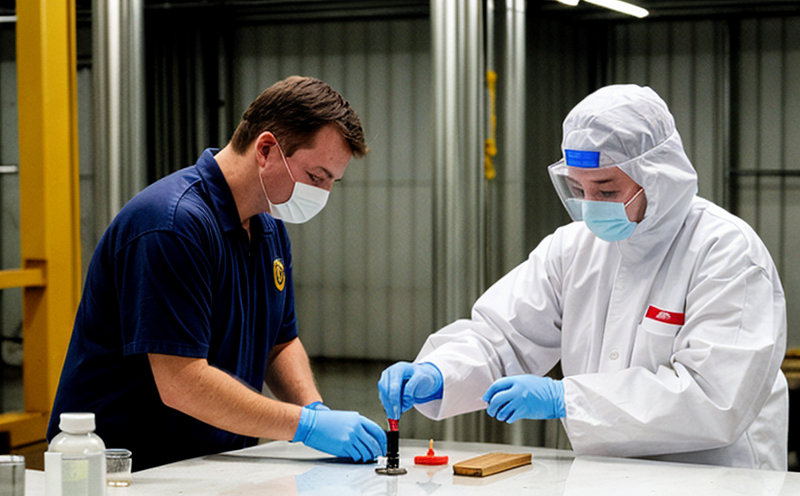ASTM D872-20 Moisture and Temperature Exposure
The ASTM D872-20 moisture and temperature exposure test is a critical method for evaluating the durability of packaging materials under controlled environmental conditions. This standard, part of the American Society for Testing and Materials (ASTM) suite of standards, provides a standardized approach to exposing specimens to moisture and temperature variations that mimic real-world storage and shipping conditions.
The test involves placing samples in an environment where they are subjected to varying levels of humidity and temperature. The purpose is to assess how well the packaging materials can withstand these environmental stresses without compromising their integrity or performance. This testing procedure is essential for ensuring that the packaging meets safety, quality, and regulatory compliance standards.
The ASTM D872-20 method is particularly important in industries such as pharmaceuticals, food and beverage, electronics, and consumer goods, where product integrity and shelf life are of paramount importance. By simulating realistic environmental conditions, this test helps manufacturers identify potential weaknesses in their packaging designs early in the development process.
During the ASTM D872-20 testing, specimens are exposed to a series of temperature cycles that simulate real-world storage conditions. These cycles can range from -15°C to +49°C with varying relative humidity levels. The test subjects the samples to these conditions for specific durations and then assesses any changes in properties like tensile strength, elongation at break, or color change.
The testing process is conducted using a climatic chamber that can precisely control temperature and humidity levels. Samples are typically placed inside this chamber where they undergo cycles of moisture absorption followed by drying. The rate and extent of moisture absorption and desorption are monitored to evaluate the packaging's ability to maintain its integrity under these conditions.
After exposure, specimens are carefully analyzed for any changes in their physical properties or appearance. This analysis may include measuring dimensions, observing color changes, or performing mechanical tests like tensile strength measurements. The results of these assessments provide valuable insights into the packaging's performance and durability.
The ASTM D872-20 method is widely recognized for its reliability in predicting how packaging materials will perform under actual use conditions. This makes it an indispensable tool for quality assurance teams, compliance officers, and R&D engineers responsible for ensuring that products meet strict industry standards.
By implementing this test early in the product development cycle, manufacturers can identify potential issues with their packaging design or materials before they reach production stages. This proactive approach not only enhances product quality but also reduces costs associated with rework and recalls.
Applied Standards
The ASTM D872-20 test is based on the standard practice for determining moisture sorption isotherms of plastics. This method is widely recognized in the industry as a reliable way to assess packaging materials under controlled environmental conditions.
In addition to ASTM D872, other relevant standards include ISO 14639 and EN 12007-2, which provide similar methodologies for evaluating moisture sorption properties of plastics. These international standards are used globally and offer consistent guidelines for testing moisture resistance in packaging materials.
The test procedure outlined in ASTM D872 involves exposing specimens to a series of temperature cycles that simulate real-world storage conditions. The method specifies precise parameters such as the range of temperatures, relative humidity levels, and exposure durations. These controlled environments allow for accurate assessment of how well the packaging materials can withstand moisture absorption and subsequent drying cycles.
By following these standardized procedures, laboratories ensure consistency and repeatability in their testing results. This is crucial not only within individual organizations but also across different regions and countries where compliance with international standards is necessary. The use of internationally accepted methods like ASTM D872 enhances the credibility and reliability of test results, making them more widely applicable.
Benefits
- Enhanced Product Integrity: Identifies potential weaknesses in packaging design early, ensuring that products maintain their integrity during storage and transportation.
- Regulatory Compliance: Ensures that packaging meets stringent industry standards, facilitating compliance with local and international regulations.
- Cost Efficiency: By identifying issues before production, it reduces the need for costly rework or recalls, leading to significant savings in both time and resources.
- Informed Decision-Making: Provides valuable data that can be used by quality managers, R&D engineers, and procurement teams to make informed decisions about material selection and design improvements.
International Acceptance and Recognition
The ASTM D872-20 moisture and temperature exposure test is widely accepted and recognized across various sectors, including pharmaceuticals, food and beverage, electronics, and consumer goods. Its broad applicability makes it a cornerstone of quality assurance programs worldwide.
This method has been embraced by regulatory bodies such as the FDA (Food and Drug Administration) in the United States, which mandates rigorous testing to ensure product safety and efficacy. Similarly, organizations like the European Medicines Agency (EMA) recommend this type of testing for pharmaceutical packaging materials.
The test is also recognized by standards-setting bodies such as ISO (International Organization for Standardization) and EN (European Norms), ensuring that it remains consistent with global best practices. This international acceptance underscores its importance in maintaining high-quality packaging standards across diverse industries.





